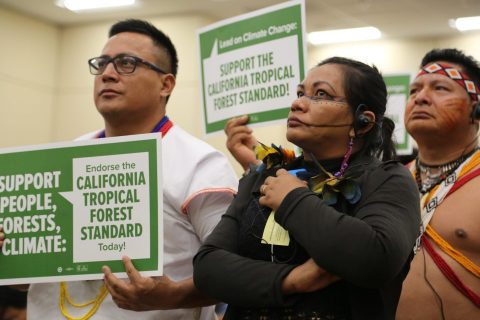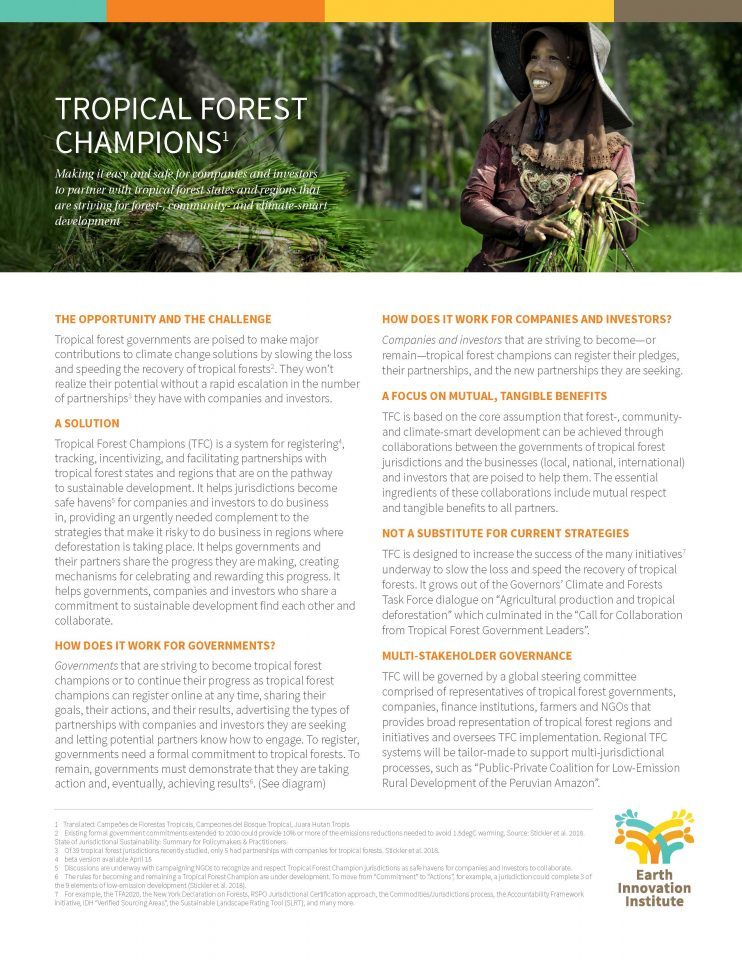Tropical forests and climate in 2019: hopes fulfilled, hopes dashed, hopes delayed
Back in January I wrote about my 13 hopes for tropical forests and climate change in 2019. As the year draws to a close, here’s a look back at which hopes were fulfilled, which were dashed, and which will carry over into 2020. While headlines in 2019 were dominated by prominent failures on forests and climate in Brazil, the United States, and the United Nations, important progress happened in California, three Andean countries, and even in space.
Hope fulfilled: California Air Resources Board endorses a Tropical Forest Standard.
What I wrote in January: “Endorsing the standard wouldn’t lead directly to offsets, but it would set a high bar for the quality of emission reductions from tropical forest conservation that could be bought and sold by others.”
What happened in 2019: The California Air Resources Board endorsed the California Tropical Forest Standard in September. The Standard has the potential to channel hundreds of millions of dollars toward protecting forests, supporting sustainable development and preventing climate change.

Hope fulfilled: Ecuador accesses first results-based payments from the Green Climate Fund.
What I wrote in January: “Ecuador is one of three countries to have completed all four UNFCCC pre-requirements for reducing emissions from deforestation (REDD+). This makes it eligible to access a portion of the $500 million allocated by the Green Climate Fund for results-based payments for REDD+.”
What happened: In July the Green Climate Fund approved results-based payments to Ecuador of $18.6 million for 3.6 million tons of CO2 avoided in 2014.
Hope fulfilled: Proceeds from Colombia’s carbon tax support forest conservation.
What I wrote in January: “A quarter of the proceeds [from Colombia’s tax on carbon dioxide emissions] go into a ‘Sustainable Colombia Fund’ for protecting ecosystems, coastlines, and water sources. By March the Fund is expected to open a call for proposals.”
What happened in 2019: The Sustainable Colombia Fund opened two calls for proposals for projects working to protect and restore forests. (Credit: Maria Adelaida Fernandez Muñoz)
Hope fulfilled: Peru’s palm oil industry vows to grow without deforestation.
What I wrote in January: “The palm oil industry in Peru has big plans to keep growing, but a broad-based coalition would like this expansion to happen on cleared lands rather than at the expense of forests as in Indonesia and Malaysia.”
What happened in 2019: The Peruvian Palm Oil Producers’ Association (JUNPALMA) announced a commitment to sustainable and deforestation-free palm oil production at the Expo Amazónica trade fair in Iquitos in August. However, the pact has yet to be signed. (Credit: Gustavo Suarez de Freitas)
Hope fulfilled: The International Space Station maps forests in 3-D.
What I wrote in January: “Forest-monitoring lasers will soon be mounted on the International Space Station…and they should start sending back three-dimensional measurements of tropical and temperate forests by May.”
What happened in 2019: The space station-mounted lasers are “operating beautifully,” according to Professor Scott Goetz of Northern Arizona University, and have already sent back two months of data. The mission, which makes its data freely available to all, will increase the number of data points on how much carbon is stored in tropical forests by more than a thousand-fold, from millions to billions. This giant leap in reliable carbon measurement should in turn galvanize results-based finance for forest protection. (Credit: Scott Goetz)
Hope dashed: United States Government restores climate funding.
What I wrote in January: “When the new [United States House of Representatives] majority takes office in January I’m hoping they’ll use their ‘power of the purse’ to restore funding for clean energy, earth observation, and the Green Climate Fund.”
What happened in 2019: While divided government has stopped some of the bleeding of Congressional funding for climate programs, the U.S. is still overdue on promised payments to the Green Climate Fund, and a budget deal reached in mid-December axed subsidies for renewable energy. Jumpstarting federal funding is one of many ways the next American President can lead on climate and forests.
Hope dashed: Brazil’s forests dodge a Bolsonaro-shaped bullet.
What I wrote in January: “When Brazil’s world-class PRODES deforestation data is released in November, I’ll be hoping that strong civil society partnerships and positive incentives for farmers have contained Bolsonaro’s threats to be more bark than bite.”
What happened in 2019: Massive, deliberately-set fires across the Amazon darkened the skies above São Paulo and sparked headlines around the world. PRODES data released in November showed that an area of the Amazon larger than Puerto Rico had been deforested in the last year—the highest annual forest loss since 2007, though still half the average from 1996-2005. In September Dan Nepstad testified before Congress on what the U.S. can do to help Brazil protect the Amazon.
Hope dashed: At the United Nations climate summit in Chile countries step up their pledges—and finance.
What I wrote in January: “Ever since the successful Paris agreement in 2015…climate diplomats have turned their attention to ironing out the details of the Paris ‘rulebook.’ Let’s hope 2019 sees stronger climate action from all countries, matched by the funding to make it happen.”
What happened in 2019: The UN climate convention saw no deal on crucial rules surrounding international carbon trading. Commitments of emission-reductions and finance were moribund as well. The clock is ticking ahead of a deadline for countries to strengthen mitigation and finance commitments next year.
Hope dashed: Companies and states agree to sustainable sourcing partnerships.

What I wrote in January: “More than 400 of the world’s biggest companies resolved in 2010 to achieve zero net deforestation by 2020…One potential solution is for companies to source their products from states or provinces that curtail deforestation—a jurisdictional approach.”
What happened in 2019: Not a single company is on track to achieve the 2020 deadline for zero net deforestation, and sustainable sourcing partnerships between companies and jurisdictions continue to be formed at a remarkably slow rate. In 2019 EII launched Tropical Forest Champions, an initiative to make it easy and safe for companies to invest in tropical forest states that are striving for forest-, community-, and climate-smart development. Other institutions such as the Tropical Forest Alliance are moving forward with jurisdictional approaches as well.
Hope delayed: Carbon Fund payments help Democratic Republic of the Congo protect globally important peat forests.
What I wrote in January: “Last September [the Democratic Republic of Congo] and the Forest Carbon Partnership Facility Carbon Fund signed an ‘emission reductions payment agreement’ that would provide up to $55 million if—and only if—deforestation stays low in the peat-rich province of Mai Ndombe. I hope Congo’s first-of-its-kind agreement with the Carbon Fund leads to low-emission rural development with local benefits, and that the Carbon Fund will sign similar agreements with other tropical regions when it meets in June in Paris.”
What happened in 2019: Not even the advance payment has been made from the notoriously slow 11-donor Carbon Fund to the Democratic Republic of Congo, as the country has yet to demonstrate the Carbon Fund’s five “conditions of effectiveness.” On a positive note, the Carbon Fund signed emission reductions payment agreements with Mozambique and Ghana, while Gabon signed a $150 million results-based forest-protection agreement with Norway in September. (Credit: Daniela Goehler)
Hope delayed: Airlines turn to forests to meet carbon-neutral growth pledge.
What I wrote in January: “In 2016 many of the world’s airlines pledged not to increase net emissions…partly by cutting emissions but also through offsets. It’s now up to the Montreal-based International Civil Aviation Organization (ICAO) to decide which offsets will be acceptable. I hope they…includ[e] forest-based offsets but only if standards are high—e.g. national or state-level reductions rather than project-level credits like those left over from the Clean Development Mechanism.”
What happened in 2019: ICAO set out general criteria for offsets in February as scheduled. ICAO’s vetting of the 14 specific standards that have been submitted as potential offsets suppliers will carry over into 2020. (Credit: Maggie Comstock)
Hope delayed: India’s finance commission extends fiscal transfers for forests.
What I wrote in January: “In 2014 India’s Finance Commission made the groundbreaking decision to include forest cover in the formula that determines how much tax revenue each of India’s 29 states receives annually. In September the tax-revenue devolution formula comes up for renewal.”
What happened in 2019: The decision of the Finance Commission has been delayed until October, 2020. Meanwhile Avani Kapur, Anit Mukherjee and I found that Indian states aren’t yet increasing their forestry budgets as an investment in future tax revenue, likely because they haven’t been expecting increases in forest cover to be rewarded with increases in tax revenue. To correct this, the Finance Commission should keep forests in the tax revenue distribution formula and update the year when forest area is measured to account for states’ recent forest growth.
Hope delayed: Indonesia’s drop in deforestation survives another fire season.
What I wrote in January: “Past drops in Indonesia’s deforestation following El Niño years have proven ephemeral. Will this one last? The World Meteorological Organization predicts a weak El Niño in 2019, which will put Indonesia’s fire-prevention efforts to the test.”
What happened in 2019: Though overshadowed by fires in the Amazon, fires associated with deforestation raged across Indonesia as well, causing an estimated $5.2 billion in damages. The nearly one million hectares burned was more than twice the average area burned the last three years, but still less than half the area that burned in the 2015 El Niño year. Research is needed to assess how much of the drop from 2015 can be attributed to the Indonesian government’s efforts. (Credit: Nindita Hapsari, Matt Warren, Triyoga Widiastomo)
All in all, some hopes for tropical forests and climate change were dashed or delayed in 2019, but several noteworthy hopes were fulfilled too. We at Earth Innovation Institute are resolved to fulfill more hopes in 2020—please join us in making that happen.


